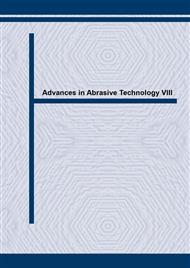p.561
p.567
p.573
p.579
p.585
p.593
p.597
p.603
p.609
Effect of Tool Segmentation in Ultrasonic Machining - Studies of Ultrasonic Die Sinking -
Abstract:
If a circular section tool is used for ultrasonic machining, cavitation occurs at its center. This cavitation suppresses the penetration of abrasive grains and leaves a projection at the center of a machined hole. On a square section tool, a cavitation vortex appears symmetrically on a diagonal line to promote the penetration of abrasive grains and makes the machining rate greater than that for a circular section tool. If the aspect ratio (ratio of vertical and horizontal dimensions) of the tool section is changed, the cavitation vortex changes the machining rate even when the sectional area is the same. For confirmation in detail, square section tools of different aspect ratios were created and used for SiC ultrasonic bottom die sinking to survey the machining characteristics. At the same time, tools having segmented square sections were checked for the occurrence of cavitation, and the influence on the height of the projection generated by machining was studied. Consequently, a 4-segmented tool of 3 × 4.2 mm minimized the cavitation in each element and produced the greatest machining rate of 2.26 µm/s. In every machined hole, the tool suppressed the projection height within 50 µm.
Info:
Periodical:
Pages:
585-592
Citation:
Online since:
August 2005
Authors:
Price:
Сopyright:
© 2005 Trans Tech Publications Ltd. All Rights Reserved
Share:
Citation:


